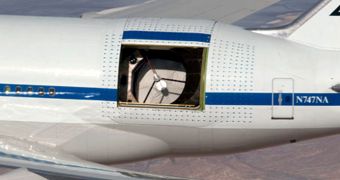Experts at NASA carried out a series of tests and verifications aboard the SOFIA aircraft last month, in preparation of early astronomical science flights, which mission controllers plan to start soon.
During the tests, the heavily-modified 747SP was taken out of its hangar, and its telescope made to look at the stars. This allowed science teams to check a host of systems and subsystems.
With all functionalities at nominal levels, the Stratospheric Observatory for Infrared Astronomy is now ready to take to the skies, and start conducting actual science flights. The aircraft has been under development of years,
It represents a joint initiative of NASA and the German Aerospace Center (DLR), and the aircraft is made up of a Boeing jumbo jet which carries a large telescope at the back. The infrared observatory can observe stars through a door carved in the side of the airplane.
There are numerous benefits to conducting observations using such a machine. For starters, it can see stars from vantage points that are inaccessible to ground-based telescopes, at a fraction of the costs associated with launching a new space observatory.
SOFIA can fly above cloud cover, which is very useful in the Northern Hemisphere. This half of the world is notoriously unsuitable for astronomical observations, due to large and persistent cloud covers.
But, using this aircraft, it is possible to conduct observations from places where it's simply unfeasible to construct a full ground-based telescope. The airplane can remain airborne for hours, and has the ability to keep its main mirror pointed at the same point in the sky despite other manuevers.
According to SOFIA's principal investigator Terry Herter, who leads a team of researchers at the Cornell University, in Ithaca, New York, the Faint Object Infrared Camera for the SOFIA Telescope (FORCAST) instrument will soon be used to conduct science.
The camera has been installed on the SOFIA main telescope and is now ready to use. The Mission Control and Communication System has also been upgraded to support further functionalities.
In the October tests, the pointing stability of the telescope assembly and accuracy of line-of-sight resets were also tested and calibrated, Space Fellowship reports.
During subsequent tests carried out on November 2 and 3, the ground team also assessed the functionality of the Fast Diagnostic Camera, which was developed by the German SOFIA Institute in collaboration with the University of Stuttgart.
“SOFIA is set to achieve some spectacular science. For instance, this telescope will help us figure out how planets form and how our own solar system came to be,” project scientist Pamela Marcum explains.
The 17-ton, nine-foot wide telescope will have an impressive advantage over other observatories when it begins its work, as it will be able, for example, to be scrambled into the air shortly before stellar occultations begin.
During these events, an object such as an exoplanet moves in front of a star, and temporarily blocks a part of or all of its light.
“SOFIA will be able to locate the 'planetary snowline,' where water vapor turns to ice in the disk of dust and gas around young stars. That's important because we think that's where gas giants are born,” Marcum adds.

 14 DAY TRIAL //
14 DAY TRIAL //